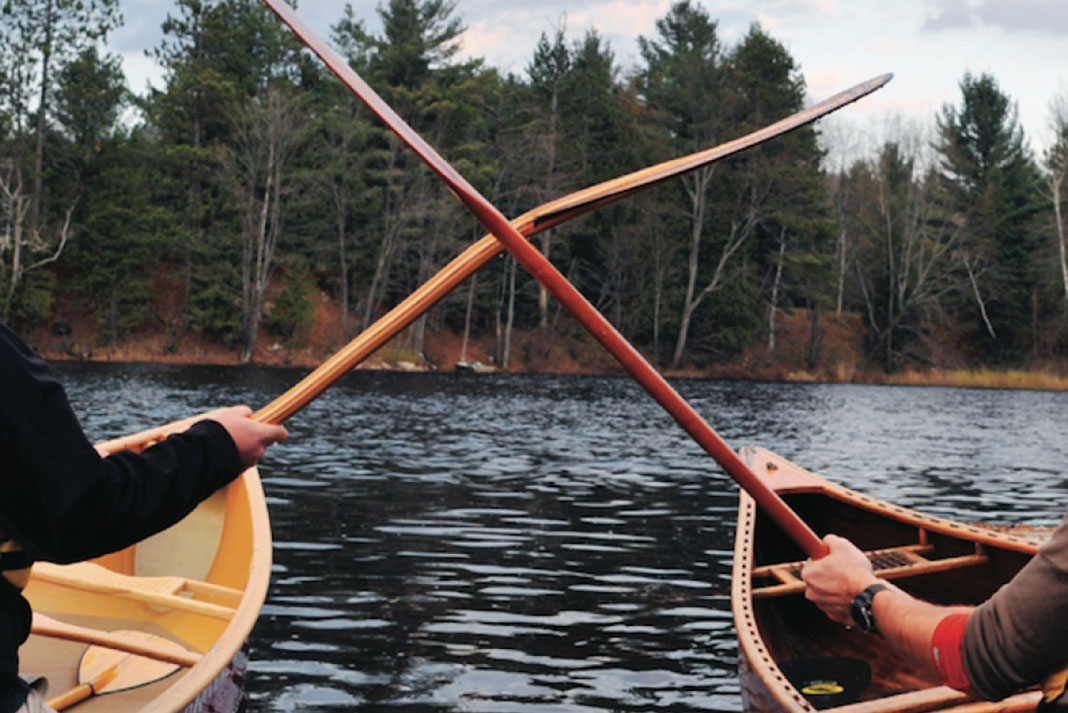Much debate and conjecture have surrounded the argument for straight shaft versus bent shaft canoe paddles, and vice versa. We asked two of lakewater canoeing’s most respected paddlers—Boundary Waters veteran and bent shaft believer Cliff Jacobson, and guidebook author and straight shaft advocate Kevin Callan—to defend their chosen sticks. They leapt at the opportunity like gallant knights called to duty. Jacobson and Callan duel with words and paddles rather than swords and shields, but the result is every bit as entertaining…and vicious.
Bent vs. straight shaft canoe paddles
En garde
Cliff Jacobson: When I learned that Kevin prefers straight paddles to bent blades for lake cruising, I just rolled my eyes. I fear that boy has spent too much time in the Ontario bush!
Kevin Callan: I don’t use a bent shaft paddle. The reason is simple. I’m Canadian. Bent shaft paddling is the domain of Boundary Waters canoeheads, hence the term Minnesota Switch to describe their characteristic stroke.

Touché
KC: I tried a bent blade and immediately saw the appeal for beginner paddlers. First-time canoeists automatically attempt to travel in a straight line by switching their paddles from side to side. Paddling with a bent shaft encourages this natural reaction, with the stern paddler hollering “Hutt!” every three strokes to indicate the right moment for both paddlers to switch. But I’m not a greenhorn canoeist, so using the J stroke, or even better, the Canadian stroke, gets me across the lake straight and in style.
CJ: The fact is, every performance-minded canoeist on the planet prefers a bent shaft for racing, cruising and general all-round canoeing. Even your precious J stroke is best done bent. Why? Because the bent blade runs partly under the canoe during the stroke, whereas a straight blade runs alongside. It is a canoeing axiom that the closer to the keel line you paddle, the less directional correction is needed.
Regardless of how you paddle, the efficiency of bent blades beats straight shafts hands-down. A straight paddle lifts water at the end of the stroke, slowing the canoe. With a bent paddle, the water is pushed nearly straight back.
Parry
KC: I respect the physics behind the bent shaft. However, I’ve never cared about how fast I go while out there.
Speaking of physics, bent shafts are crap when it comes to maneuverability—try one in fast water or to turn quickly. A straight blade acts the same in both directions. If you’re doing a draw and immediately want to pry, you can. It’s the difference between wrapping your canoe around a rock mid-rapid or running a perfect line.
CJ: It’s not about speed. It’s about efficiency and being kind to your body. Paddling a straight shaft is all pull back. With a bent paddle, it’s more push down. This reduces stress on your arms and back. There is also less twisting of the shaft and your hand during the stroke, minimizing carpal tunnel and tennis elbow injuries. This is a huge advantage if you are paddling solo for hours at a time. As to maneuverability, I’ll reluctantly concede that for serious rapids, straight blades do rule.
Coup de grace
KC: I generally keep myself healthy and fit by paddling a lot and not forcing each stroke. I can’t think of anything more relaxing and effortless than Canadian stroking down a lake with a five- to six- inch-wide straight shaft, wooden paddle. Call using a traditional paddle crazy. Or accept it as a choice that reflects the real reason we go on canoe trips in the first place—to slow down.
But heck, if Cliff and I go paddling together, it would work out perfect if he was in the bow with the power of a bent shaft and I was in the stern with the poise of a straight shaft. We’d be like a married couple dancing across the lake.
CJ: Yeah, Kevin, I get it. What a deal! I’m actually all for slowing down. Frankly, I find that lollygagging along with a bent shaft is far more relaxing. But then, I use a pitch stroke that maximizes the advantage of the bent blade.
Kevin won’t like me having the last word, but for all you non-Luddites I’d like to share this final tip: There are good and bad bent shaft paddles. My favorites are made of carbon fiber and have 12-degree bends.
This article was first published in the Spring 2011 issue of Canoeroots Magazine. Subscribe to Paddling Magazine’s print and digital editions, or browse the archives.
Which type of canoe paddle reigns supreme, bent or straight shaft? It all depends on your perspective. | Feature photo: Virginia Marshall



